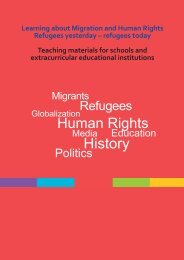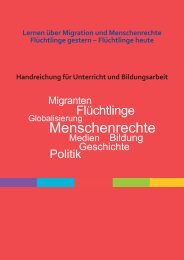IMMIGRATION IN ITALY By Laura Zanfrini* 1. From a source to a ...
IMMIGRATION IN ITALY By Laura Zanfrini* 1. From a source to a ...
IMMIGRATION IN ITALY By Laura Zanfrini* 1. From a source to a ...
- No tags were found...
Create successful ePaper yourself
Turn your PDF publications into a flip-book with our unique Google optimized e-Paper software.
ultimately kept up with a repeated resort <strong>to</strong> “exceptional” regularization actions. The number ofmigrants who have been “regularized” is so important as <strong>to</strong> significantly weigh not only upon theresident foreign population volume, but also upon the whole population itself. An overwhelmingmajority of regular migrants who live and work in Italy have been through an irregular approachwith the country and by a more or less long permanence in illegal conditions. Quite often, eventhose who have always been regular migrants succeeded in migrating thanks <strong>to</strong> the presence of arelative who had passed <strong>to</strong> legality through an amnesty. This datum alone provides tangibleevidence of the failure of sovereignty, or better, of its central manifestation, which in thecontemporary international juridical paradigm is represented by control on migration flowmovements. The price that the Italian society is going <strong>to</strong> pay represents a dangerous discredit of theprinciple of legality, with all the consequences that this implies for the social cohesion.3. The evolution of Italian legislationTraditionally an emigration country <strong>to</strong>wards America, Australia and Northern Europe, Italyexperienced a migration turning point between the late 1970s and the early 1980s, that is, during apeculiar stage of the his<strong>to</strong>ry of international migrations, characterized by the rise of restrictivepolicies, and particularly, by the closing of the traditional Central-North-European destinationareas. The role of his<strong>to</strong>rical and political fac<strong>to</strong>rs in structuring migration flows has been by far lessimportant than in other European countries with an earlier migration tradition. Those migrationflows were in fact “spontaneous”, and migrants began <strong>to</strong> flow independently of any activerecruiting policy, usually with no links with the colonial past, attracted by the relative facility withwhich they could enter the country and stay despite an irregular status, and by the possibility <strong>to</strong>mask the real motivations of their permanence, considering Italy’s <strong>to</strong>urist vocation. Along withoffering many opportunities <strong>to</strong> include those migrants in shadow economy, this phenomenoncontributed <strong>to</strong> further increase a widespread irregularity, in terms of persons’ presence and labour,and was destined <strong>to</strong> weigh for a long time upon integration processes <strong>to</strong> such an extent as <strong>to</strong> beidentified as one of the distinctive features of what was later called, by some authors, the“Mediterranean immigration model”. It <strong>to</strong>ok several years <strong>to</strong> make Italy, as well as the other South-European countries, aware of its new role within the international migration system, and an evenlonger time before it recognized the existence of requirements for imported labour, considering thesudden turnabout of its demographic trends. In a situation of overall normative and institutionaldeficit, which characterized Italy’s migration transition, lay and religious associations andorganizations acted as real substitutes for an insufficient and inadequate public intervention action(<strong>to</strong> such an extent that several scholars talk about a situation of “functional overload” in charityorganizations, which were obliged <strong>to</strong> make themselves responsible also for tasks that did notconcern them).Juridical vagueness has thus become a basic element in the structure of the relationsbetween immigrants and Italian society. In fact, the first law on immigration dates back <strong>to</strong> 1986,that is, more than ten years after the “turning point” of 1974 (the year in which, as we have seen, forthe first time the number of incoming foreigners exceeded that of the Italians who emigratedabroad). Law 943/1986, besides establishing an entry and access mechanism <strong>to</strong> the labour market(which however remained substantially not enforced), granted equal protection <strong>to</strong> Italian andforeign workers, and acknowledged <strong>to</strong> the latter a few social rights, including the right <strong>to</strong> familyreunifications. Broader was the reach of the so-called “Martelli Law” (Law 39/1990), which besidesintroducing a yearly flow planning system, also laid down some regulations concerning foreigners’legal protection, expulsion, asylum, and self-employment.The first organic set of rules came only in 1998, through the passing of the “Napolitano-Turco” Law (Law Decree 286/98), which was also the fruit of the pressures of third-sec<strong>to</strong>rinstitutions and civil society. In countertendency with the juridical frame prevailing in Europe inthose years, this law acknowledged, along with pull fac<strong>to</strong>rs in the sending countries, also theexistence of attraction elements strictly connected with Italy’s economic requirements for imported<strong>Laura</strong> Zanfrini, Immigration in Italy, June 30, 2013. 7







